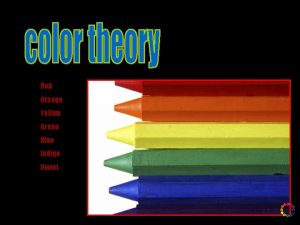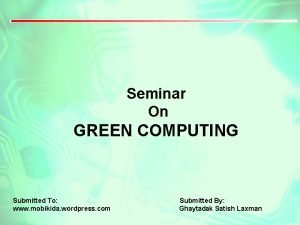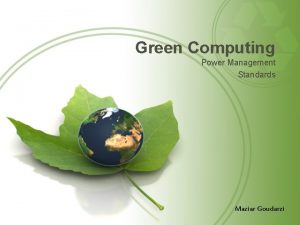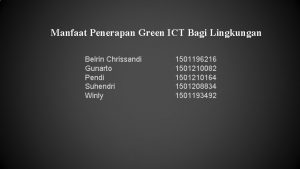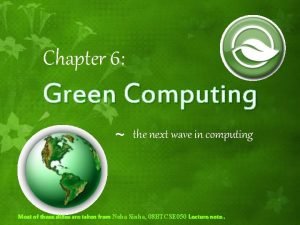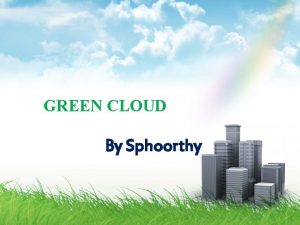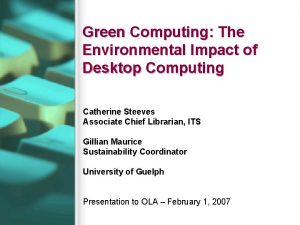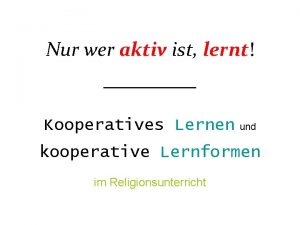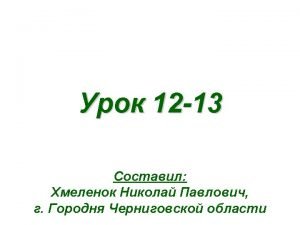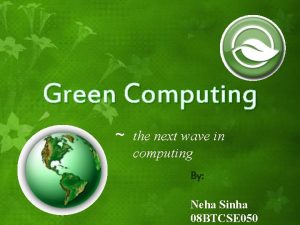Chapter 6 Green Computing the next wave in


























- Slides: 26

Chapter 6: Green Computing ~ the next wave in computing Most of these slides are taken from Neha Sinha, 08 BTCSE 050 Lecture note.

Introduction Ø The study and practice of designing, manufacturing, using, and disposing of computers, servers, and associated subsystems, such as monitors, printers, storage devices, and networking and communications systems — efficiently and effectively with minimal or no impact on the environment.

What is Green Computing? Ø Green computing is the study and practice of using computing resources efficiently. Ø The primary objective of such a program is to account for the “Triple Bottom Line”: (People, Triple Bottom Line Planet , Profit). Ø The goals are similar to green chemistry which aims at promoting recyclability or biodegradability of products and factory waste.

Green Computing – Why ? Ø Maximized energy consumption. Ø Lack of green energy. Ø The extensive use of paper and other consumables used. Ø Higher extent of equipment disposal requirements.

History Ø The term “Green Computing" was probably Green Computing coined shortly after the ‘Energy Star’ program began way back in 1992. Ø One of the first results of green computing was the “Sleep mode” function of computer monitors. Ø As the concept developed, green computing began to encompass thin client solutions, energy cost, accounting, virtualization practices, e-Waste, etc.

Pathway towards Greening 1. Green Use: Intelligent use of energy and information systems. 2. Green Disposal: Reduction of waste, reuse and refurbishment of hardware and recycling of out of use peripherals and other items. 3. Green Design: Efficient design of data centres and workstations. 4. Green Manufacture: Informed purchasing of components, peripherals and equipments manufactured with the environment in mind.

Approaches to “Green Computing” 1. Virtualization Computer virtualization is the process of running two or more logical computer systems on one set of physical hardware.

2. Power Management ACPI allows an operating system to directly control the power saving aspects of its underlying hardware. 3. Power Supply Climate savers computing initiative promotes energy saving and reduction of greenhouse gas emissions by encouraging development and use of more efficient power supplies.

4. Storage Desktop Hard Drive 5. Display CRT Display Laptop Hard Drive Solid State Drive Less Energy LCD Display LED Display

6. Material Recycling Parts from outdated systems may be salvaged and recycled through certain retail outlets or private recycling centers. 7. Telecommuting Teleconferencing technologies implemented in green computing initiatives have advantages like increased worker satisfaction, reduction of greenhouse gas emissions related to travel and increased profit margins.

Recent Implementation of “Green Computing” Ø Blackle § Blackle is a search-engine site powered by Google Custom Search. §Blackle came into being based on the concept that when a computer screen is white, presenting an empty word page or the Google home page, your computer consumes 74 W. §When the screen is black it consumes only 59 W.


Ø Zonbu Computer § The Zonbu is a new, very energy efficient PC. § The Zonbu consumes just one third of the power of a typical light bulb. § The device runs the Linux operating system using a 1. 2 GHz processor and 512 MB of RAM.

Ø Fit- PC § Fit-PC is the size of a paperback and absolutely silent, yet fit enough to run Windows XP or Linux. § Fit-PC is designed to fit where a standard PC is too bulky, noisy and power hungry. §Fit-PC draws only 5 Watts, consuming in a day less power than a traditional PC consumes in 1 hour.

Ø Sun. Ray Thin Client §What does a thin client mean? §Thin clients like the Sun Ray consume far less electricity than conventional desktops. § A Sun. Ray on a desktop consumes 4 to 8 watts of power, because most of the heavy computation is performed by a server. § Sunrays are particularly well suited for cost-sensitive environments such as call centres, education, healthcare, service providers and finance.

Ø Asus Eee PC & ultra portables § Small Size. § Fairly low- power CPU. § Compact screen. § Low cost. § Uses flash memory for storage.

Role of I. T. Vendors

§ Awareness §Product Design § Materials §Energy Efficiency §Recycling

Global Education & Public Awareness Raising • People must understand the danger and responsibilities. • Governments, organizations, professional, and communities need to cooperate in developing and spreading the appropriate green practices. • Wall-E : An animated movie (science fiction) produced by PIXAR called “Wall E” the story predicts the future of our planet if we still act carelessly about current waste. The earth will covered with garbage and all humankind will leave the earth and live on the outer space. WALL-E, short for Waste Allocation Load Lifter Earth-class, is the last robot left on Earth. He spends his days tidying up the planet, one piece of garbage at a time.

Energy Can be saved by • Turning off idle PCs. • Lower power hardware. • Cloud computing services: SAAS, IAAS, PAAS? • Server virtualization. • Hardware as a service. • Dematerialization. • Energy efficient coding could cut energy use by up to 30%

Leading Companies in Green Computing • IBM Project Big Green • 2900 servers, 30 mainframes, 80% saving. • Amazon infrastructure services • Amazon Elastic Compute Cloud. • Intel Green Processors • Intel has released in 2008 the most energy efficient, emission reduction device ever created.

Green Solution by IBM, Intel, & Amazon cloud services IBM Project Big Green Dematerialization by web downloads Intel processors

Three Types of Cloud Computing • Cloud Computing is all about online sharing of resources. • Resources includes: software, hardware (infrastructure & platform), and data (storage). • Advantages: cost reduction, virtualization, increasing mobility & productivity. 1. Software as a Service (SAAS) • Allows users to run an existing online software (application). e. g. Google docs. 2. Platform as a Service (PAAS) • Allows users to create their own cloud applications using supplier-specific tools and programming languages offered by the cloud provider. e. g. Google force. com. 3. Infrastructure as a Service (IAAS) • Allows users to run whatever applications they require on the cloud hardware. (server virtualization). E. g. Amazon EC 2

More Computing Solutions: Computer can be used to: • Increase business efficiency. • Computing has already saved more resources than it has consumed. • Travel Reduction. • By using video conferencing, many companies has replaced travel offices by meeting offices. • Dematerialization. • Digital downloads and web-based information services instead of physical products: Downloading applications and media instead of buying CDs.

Conclusion Ø So far, consumers haven’t cared about ecological impact when buying computers, they’ve cared only about speed and price. Ø New green materials are developed every year, and many toxic ones are already being replaced by them. Ø The greenest computer will not miraculously fall from the sky one day; it will be the product of years of improvements. Ø The features of a green computer of tomorrow would be like: efficiency, manufacturing and materials, recyclability, server model, self-powering and other trends.

Recommended Reading & Discussion http: //bipublication. com/files/csv 1 i 120107. pdf Give some example products (software, hardware and techniques ) for green computing. Propose some ideas on how to effectively raise the awareness and utilization of green computing.
 X.next = x.next.next
X.next = x.next.next Red green show
Red green show Next wave internet
Next wave internet Conventional computing and intelligent computing
Conventional computing and intelligent computing Purple
Purple Transverse wave vs longitudinal wave
Transverse wave vs longitudinal wave What is a semiconductor used for
What is a semiconductor used for Difference between full wave and half wave rectifier
Difference between full wave and half wave rectifier Example of longitudinal wave
Example of longitudinal wave Examples of half wave rectifier
Examples of half wave rectifier What is centre tapped full wave rectifier
What is centre tapped full wave rectifier Earthquake p-wave and s-wave travel time graph
Earthquake p-wave and s-wave travel time graph Full wave rectified sine wave fourier series
Full wave rectified sine wave fourier series Wave wave repeating
Wave wave repeating The wave chapter 10
The wave chapter 10 L
L Mechanical and electromagnetic waves venn diagram
Mechanical and electromagnetic waves venn diagram Mechanical waves and electromagnetic waves
Mechanical waves and electromagnetic waves Wavelength formula triangle
Wavelength formula triangle Seminar on green computing
Seminar on green computing Tddd50
Tddd50 Contoh penerapan green computing di perusahaan
Contoh penerapan green computing di perusahaan Zonbu computer green computing
Zonbu computer green computing Green cloud computing architecture
Green cloud computing architecture Impact of green computing
Impact of green computing Lernpyramide von green & green (2005)
Lernpyramide von green & green (2005) Green yellow red blue
Green yellow red blue




